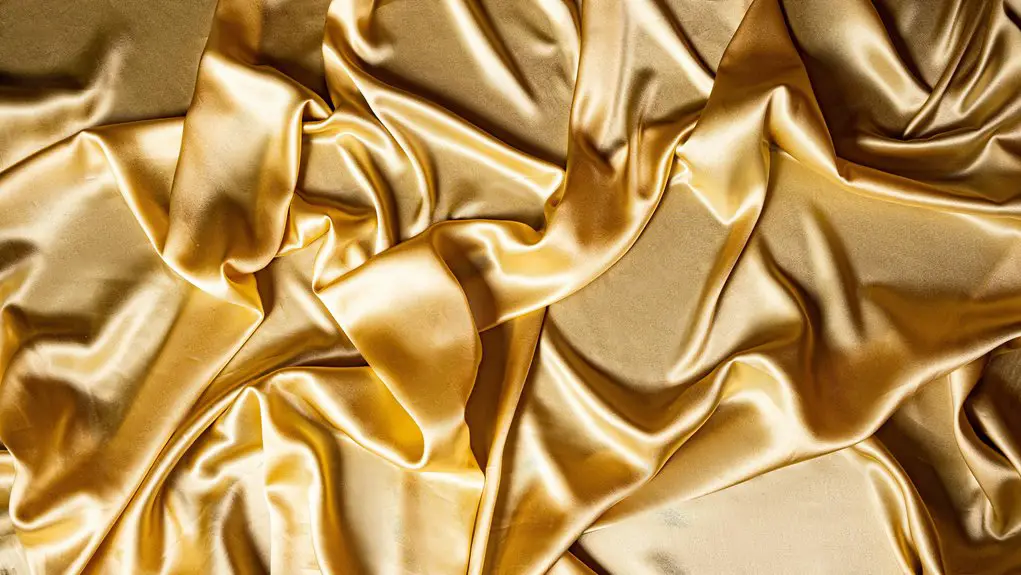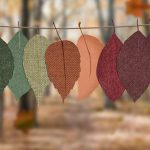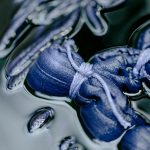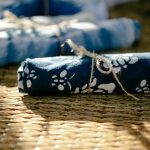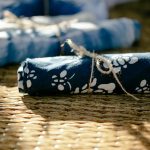To tie-dye bed sheets successfully, start by choosing natural fabrics like cotton for vibrant, lasting colors. Pre-wash your sheets to remove finishes and open fibers for better dye absorption. Use fiber-reactive dyes with squeeze bottles, secure folds tightly with rubber bands, and try popular patterns like spirals or crumples. After dyeing, set colors by wrapping sheets in plastic and carefully rinse before washing separately. Follow these basics, and you’ll be ready to explore techniques to customize and preserve your large, colorful fabric project.
Table of Contents
Key Takeaways
- Choose natural fabrics like cotton for vibrant dye absorption and pre-wash sheets to remove finishes before dyeing.
- Use fiber-reactive dyes, squeeze bottles, rubber bands, and gloves for precise application and safety.
- Employ patterns such as spirals, bullseye, crumple, or stripes to create striking large-scale designs.
- Soak sheets in soda ash solution to boost dye vibrancy and wrap in plastic to develop colors fully.
- Rinse dyed sheets until clear, wash separately with mild detergent, and air dry or tumble dry on low heat to maintain color.
Selecting the Best Fabric for Tie-Dye Bed Sheets
When choosing fabric for tie-dye bed sheets, you’ll want to focus on materials that absorb dye well and feel comfortable against your skin.
Cotton is your best bet—it’s natural, breathable, and soaks up colors beautifully, giving you vibrant results. You might also consider bamboo or linen for a softer, eco-friendly option, but keep in mind they may not hold dye as intensely as cotton.
Cotton delivers vibrant colors and breathability, while bamboo and linen offer softer, eco-friendly but less intense dye options.
Avoid synthetic fabrics like polyester since they resist dye and can leave you with dull, uneven patterns.
Also, choose a fabric with a tight weave to prevent bleeding and guarantee sharp designs.
Picking the right fabric upfront saves you frustration and helps your tie-dye sheets stay bright and comfy for years to come.
Preparing Your Sheets for Dyeing
Before you start tie-dyeing, make certain you pick sheets made from natural fibers like cotton for the best color absorption.
You’ll also want to pre-wash your sheets to remove any sizing or finishes that could block the dye.
Taking these steps helps guarantee your colors turn out vibrant and even.
Choosing the Right Fabric
Choosing the right fabric plays an essential role in achieving vibrant and lasting tie-dye results. When picking your sheets, focus on natural fibers, as they absorb dye better and hold color longer. Avoid synthetic blends that might resist dye or fade quickly.
Here’s what you should consider:
- Material: Opt for 100% cotton, linen, or rayon for the best dye absorption.
- Weave: Tightly woven fabrics provide a smoother surface and more consistent dye patterns.
- Color: Start with plain white or light-colored sheets to make your tie-dye colors pop.
- Condition: Choose sheets without finishes or coatings that can block dye penetration.
Selecting the right fabric sets a strong foundation for your tie-dye project, ensuring your bed sheets look vibrant and fresh for years to come.
Pre-Wash and Prep
Start by giving your sheets a thorough pre-wash to remove any dirt, oils, or sizing that could interfere with dye absorption.
Use a mild detergent and skip fabric softeners, as they can create a coating that repels dye.
Wash your sheets in warm water to open the fibers, which helps the dye penetrate evenly.
After washing, leave your sheets damp but not soaking wet—this moisture will help the dye spread smoothly.
Before you start tying and folding, lay the sheets flat and inspect for any stubborn stains or spots; treat those areas if needed.
Proper prep guarantees vibrant, long-lasting colors and prevents patchy results.
Taking these steps sets a solid foundation for your tie-dye project, making the process smoother and the outcome more professional.
Essential Tie-Dye Tools and Materials
To create vibrant tie-dye bed sheets, you’ll need a handful of essential tools and materials that make the process both fun and effective.
First, grab high-quality fiber-reactive dyes designed for cotton fabrics to guarantee long-lasting colors. You’ll also want squeeze bottles to apply dye precisely and control the saturation.
Rubber bands are vital for binding your fabric and creating unique patterns. Don’t forget protective gloves to keep your hands clean and safe from staining.
Finally, a large plastic tarp or garbage bags help protect your workspace from dye spills. With these basics, you’re set to plunge into the colorful world of tie-dye on large fabrics confidently.
- Fiber-reactive dyes
- Squeeze bottles
- Rubber bands
- Protective gloves
Popular Tie-Dye Patterns for Large Fabrics
Anyone diving into tie-dye bed sheets will find several patterns that bring out the best in large fabrics. The spiral pattern is a classic choice, creating a vibrant swirl that radiates from the center of the sheet.
Exploring tie-dye bed sheets? The spiral pattern is a timeless way to highlight large fabric beautifully.
If you want something bold yet simple, try the bullseye pattern by folding and binding concentric circles. For a more geometric look, the crumple pattern offers a random, marbled effect by bunching the fabric.
Stripes work well on bed sheets too; just fold your fabric accordion-style and secure it tightly. Finally, consider the mandala pattern, which combines symmetry and complexity, perfect for showcasing your artistic touch.
These patterns maximize the visual impact on large surfaces, making your bed sheets a stunning centerpiece.
Step-by-Step Guide to Dyeing Bed Sheets
Transform your plain bed sheets into vibrant works of art by following a simple dyeing process.
First, choose your dye colors and prepare your workspace with plastic covers to prevent stains.
Next, soak your sheets in water to guarantee the dye spreads evenly.
Then, twist or fold the fabric to create your desired tie-dye pattern and secure it with rubber bands.
Finally, apply the dye carefully, making sure to saturate the fabric without overdoing it.
- Prepare your workspace and materials
- Wet the sheets thoroughly
- Bind the fabric with rubber bands for patterns
- Apply dye evenly and thoroughly
After dyeing, let your sheets sit for 6-8 hours before rinsing with cold water to lock in the colors.
Tips for Achieving Vibrant and Even Colors
To get vibrant, even colors on your tie-dye bed sheets, start by prepping the fabric thoroughly—wash it to remove any sizing or residue.
When applying dye, use consistent pressure and saturate the fabric evenly to avoid patchy spots.
These simple steps will help your colors pop and spread smoothly across the sheets.
Prepping Fabric Properly
Although tie-dyeing can seem straightforward, prepping your bed sheets properly is essential for vibrant, even colors.
First, you’ll want to start with clean, damp fabric—this helps the dye absorb more evenly. Avoid fabric softeners, as they can create a barrier.
Next, make sure to remove any wrinkles by smoothing or lightly ironing your sheets. Don’t forget to soak your sheets in a soda ash solution for about 20 minutes; this acts as a fixative, boosting color vibrancy.
Finally, wring out excess liquid gently to keep the fabric damp but not dripping.
- Wash sheets without fabric softener.
- Keep fabric damp for better dye absorption.
- Use soda ash soak before dyeing.
- Smooth out wrinkles before starting.
This prep sets you up for the best tie-dye results.
Dye Application Techniques
Once your sheets are prepped and ready, the way you apply dye makes all the difference in the final look. To get vibrant, even colors, apply the dye evenly and saturate the fabric thoroughly.
Use squeeze bottles for precision, especially with intricate patterns. Work quickly to prevent uneven drying and blotching. Remember, folding techniques like spirals or accordion folds create distinct color separations, so apply dye strategically to avoid muddy colors.
Avoid over-saturating one area, which can cause bleeding. After applying dye, wrap the sheets in plastic to keep them moist and let the colors develop fully.
Finally, rinse with cold water until it runs clear to lock in those vibrant hues. Your careful application will guarantee stunning, long-lasting tie-dye bed sheets.
How to Set and Fix Colors for Long-Lasting Results
Because vibrant colors can fade quickly, you’ll want to set and fix them properly to keep your tie-dye bed sheets looking fresh.
After applying the dye, it’s essential to lock in those brilliant hues so they last wash after wash. Here’s how you can do it effectively:
- Let the dyed sheets sit wrapped in plastic for 6 to 24 hours to allow the dye to fully bond with the fabric.
- Rinse the sheets in cold water until the water runs clear to remove excess dye.
- Wash the sheets separately in cold water with a mild detergent to prevent color bleeding.
- Air dry or tumble dry on low heat to avoid fading caused by high temperatures.
Following these steps will help you enjoy your colorful sheets for a long time.
Caring for Your Tie-Dye Bed Sheets After Dyeing
Keeping your tie-dye bed sheets vibrant goes beyond setting the colors correctly. To maintain their brilliance, wash them separately in cold water for the first few washes to prevent color bleeding.
Use a gentle, color-safe detergent and avoid bleach or harsh chemicals that can fade the dye. When drying, air-dry your sheets or use a low heat setting in the dryer to protect the fabric and colors.
Avoid overexposure to direct sunlight, as it can cause fading over time. Also, don’t overload the washer or dryer to reduce friction, which can wear down the fabric and dull the dye.
With these simple steps, you’ll keep your tie-dye bed sheets looking fresh and vibrant, ensuring your colorful creation lasts for many nights to come.
Creative Ideas for Customizing Your Tie-Dye Project
Anyone can add a personal touch to their tie-dye bed sheets by experimenting with different techniques and embellishments.
Adding your own techniques and embellishments makes your tie-dye bed sheets uniquely personal and creative.
You don’t have to stick to traditional patterns; mixing methods can create truly unique results. Try combining classic spirals with bold splatters or subtle ombré effects.
Beyond dyeing, consider adding texture or accents that reflect your style. Here are some creative ideas to customize your project:
- Use fabric paint to outline shapes or write meaningful quotes.
- Sew on decorative patches or embroidered designs for extra flair.
- Add fabric glue beads or sequins for subtle sparkle.
- Experiment with bleach pens to create contrast or highlight patterns.
You’ll find that these simple tweaks make your tie-dye bed sheets one-of-a-kind and even more special.
Frequently Asked Questions
Can Tie-Dye Bed Sheets Be Made Using Natural Dyes?
Yes, you can definitely make tie-dye bed sheets using natural dyes. You’ll enjoy experimenting with plant-based colors like turmeric, beetroot, or onion skins to create unique, eco-friendly patterns on your fabric.
How Do Tie-Dye Sheets Affect Sleep Quality?
Tie-dye sheets don’t directly affect your sleep quality, but their bright colors and patterns might energize or relax you depending on your preferences. Choose colors that promote calmness to help improve your sleep environment.
Are Tie-Dye Bed Sheets Safe for Sensitive Skin?
You’ll want to check if the dyes used are non-toxic and hypoallergenic. Some tie-dye sheets might irritate sensitive skin, so choosing organic or skin-friendly dyes guarantees your comfort and safety during sleep.
Can I Tie-Dye Bed Sheets Without a Washing Machine?
Remember hand-washing your favorite sweater? You can totally tie-dye bed sheets without a washing machine. Just soak, rinse, and wring them by hand—like giving your fabric a gentle, colorful bath that brings your design to life.
What Is the Environmental Impact of Tie-Dyeing Large Fabrics?
You should know tie-dyeing large fabrics uses lots of water and chemicals, which can harm the environment. You can reduce impact by using eco-friendly dyes, minimizing water waste, and properly disposing of dye runoff.
- How to Dye Lyocell Fabric: Tips for Achieving Vibrant Colors - July 14, 2025
- How to Dye Lyocell With Dylon: Step-By-Step Instructions - July 14, 2025
- Can Lyocell Be Washed? Your Complete Care and Washing Instructions - July 14, 2025

